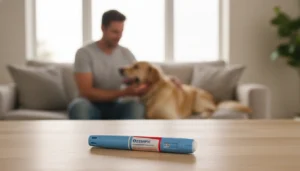How to Get Ozempic for Weight Loss: Your Comprehensive Guide

Introduction
In a world where obesity rates have reached alarming levels—affecting nearly 42% of American adults according to the Centers for Disease Control and Prevention (CDC)—the quest for effective weight loss solutions has never been more urgent. Among these solutions, Ozempic, a medication initially developed for managing type 2 diabetes, has gained significant attention for its potential weight loss benefits. But how do we navigate the process of obtaining Ozempic for weight loss? And what should we know about its effectiveness and safety?
At TrimRx, we understand that embarking on a weight loss journey can be overwhelming, especially with the myriad of options available today. In this blog post, we will explore what Ozempic is, how it works, and the steps you can take to get a prescription for it. We will also discuss alternative medications, lifestyle changes that can enhance your weight loss journey, and the importance of personalized care.
By the end of this post, you'll have a clearer understanding of how to get Ozempic for weight loss and how we at TrimRx can support you in achieving your health goals. Together, we'll explore this powerful tool and how it fits into a holistic approach to weight management.
Understanding Ozempic: What is It?
Ozempic, known generically as semaglutide, was approved by the FDA in 2017 for the treatment of type 2 diabetes. This medication belongs to a class of drugs called GLP-1 receptor agonists, which mimic a hormone that plays a key role in glucose regulation and appetite control. By mimicking the effects of this hormone, Ozempic helps lower blood sugar levels and promotes a feeling of fullness, which can lead to reduced food intake and, consequently, weight loss.
How Does Ozempic Work?
Ozempic works by acting on various systems in the body. Here are some of its primary functions:
- Appetite Suppression: It stimulates the brain's appetite control centers, helping you feel full faster and for longer periods.
- Slowing Digestion: By slowing the emptying of the stomach, Ozempic keeps you satisfied after meals, reducing the likelihood of overeating.
- Insulin Regulation: It enhances the secretion of insulin when blood sugar levels are elevated, helping to manage glucose levels effectively.
Research has shown that individuals using Ozempic can achieve significant weight loss, often comparable to what is experienced after bariatric surgery. However, it's essential to note that while Ozempic aids in weight loss, it should ideally be part of a comprehensive plan that includes dietary changes and physical activity.
How to Get a Prescription for Ozempic
Obtaining a prescription for Ozempic can be a straightforward process if you understand the requirements and steps involved. Here's how you can navigate this journey:
Step 1: Consult a Healthcare Provider
The first step is to consult with a healthcare provider who can evaluate your health and discuss your weight loss goals. This can be your primary care physician or a licensed telehealth provider. During the consultation, be prepared to discuss your medical history, current medications, and any existing health conditions.
Step 2: Determine Eligibility
While Ozempic is primarily prescribed for type 2 diabetes, some healthcare providers may prescribe it off-label for weight loss, especially if you have a body mass index (BMI) of 30 or higher, or a BMI of 27 or higher with obesity-related health conditions such as hypertension or sleep apnea. However, off-label prescriptions are often not covered by insurance, which is something to consider.
Step 3: Complete Necessary Assessments
If your provider agrees that Ozempic may be a suitable option for you, they may conduct a physical examination and order lab tests to assess your overall health. Additionally, they might calculate your BMI to ensure it aligns with the guidelines for prescribing this medication.
Step 4: Obtain the Prescription
Once you have been deemed eligible, your healthcare provider will write you a prescription for Ozempic. You can choose to fill this prescription at a local pharmacy or through an online pharmacy that partners with FDA-registered pharmacies for shipping.
Step 5: Follow Up
It’s crucial to schedule follow-up appointments with your healthcare provider to monitor your progress and adjust your treatment plan as needed. Tracking your weight loss journey and any side effects will help ensure the medication is working effectively for you.
Alternatives to Ozempic
While Ozempic can be an effective weight loss tool for some, it's not the only option available. At TrimRx, we offer a range of personalized weight loss solutions, including medications specifically designed for weight management. Here are some alternatives worth considering:
Wegovy
Wegovy, another medication containing semaglutide, is FDA-approved specifically for chronic weight management. It contains a higher dose of semaglutide compared to Ozempic and is designed for individuals with a BMI of 30 or greater or a BMI of 27 with weight-related medical conditions. If you're considering weight loss options, this medication may be worth discussing with your healthcare provider.
Compounded Semaglutide
For those who may not qualify for traditional prescriptions, compounded semaglutide offers a customizable alternative. This formulation can be tailored to meet your specific health needs, although it's important to ensure that you receive it from reputable, FDA-registered pharmacies.
Other GLP-1 Agonists
Several other GLP-1 medications, such as Saxenda and tirzepatide (Mounjaro and Zepbound), are available for weight management. Each medication has its unique benefits and may suit different individuals based on their health profiles.
Lifestyle Changes to Complement Your Medication
While medications can play a significant role in weight loss, they are most effective when combined with healthy lifestyle changes. Here are some strategies to consider:
1. Nutritional Adjustments
Adopting a balanced diet rich in whole foods, lean proteins, fruits, and vegetables can enhance your weight loss efforts. Here are some tips to help you get started:
- Increase Protein Intake: Protein helps you feel full longer and can support muscle maintenance during weight loss.
- Limit Processed Foods: Reducing your intake of sugary snacks and processed meals can help decrease calorie consumption and improve overall health.
- Stay Hydrated: Drinking plenty of water can help control hunger and support metabolic processes.
2. Regular Physical Activity
Incorporating regular exercise into your routine is crucial for effective weight management. Aim for a mix of cardiovascular exercise, strength training, and flexibility activities to boost your metabolism and maintain muscle mass.
- Set Realistic Goals: Start with achievable fitness goals and gradually increase intensity and duration.
- Find Activities You Enjoy: Whether it's dancing, hiking, or swimming, choosing enjoyable activities will help you stay motivated.
3. Mindfulness and Behavioral Changes
Developing a positive mindset and practicing mindfulness can significantly impact your weight loss journey. Consider the following approaches:
- Mindful Eating: Pay attention to your hunger cues and eat slowly to recognize when you're full.
- Set Goals: Establish clear, achievable goals related to your weight loss journey, and celebrate your progress.
Our Commitment to Personalized Care
At TrimRx, we believe that successful weight loss is not a one-size-fits-all approach. Our personalized weight loss programs are designed to meet your unique needs and goals.
By completing our free assessment quiz, you can determine your eligibility for prescription weight loss medications, including options like compounded semaglutide and other GLP-1 agonists. We also offer quick-access supplements, such as our GLP-1 Daily Support and Weight Loss Boost, which can provide additional support during your weight loss journey.
- Take Our Free Assessment Quiz: Start your journey here.
- Explore Our Quick-Access Supplements: GLP-1 Daily Support | Weight Loss Boost.
Conclusion
Navigating the world of weight loss can be challenging, but with the right information and support, you can make informed decisions about your health. Understanding how to get Ozempic for weight loss is a crucial step in this journey. By consulting with a healthcare provider, determining your eligibility, and considering alternative options, you can find the best approach to achieve your weight loss goals.
At TrimRx, we're committed to providing personalized, medically supervised care that empowers you to embrace a healthier lifestyle. Remember, effective weight management is not just about medication; it’s about creating sustainable habits that support your overall well-being.
If you’re ready to take the first step, don't hesitate to take our free assessment quiz today, and let us help you on your journey to a healthier you.
FAQ
Is Ozempic FDA-approved for weight loss?
Ozempic is not FDA-approved specifically for weight loss; it is approved for managing type 2 diabetes. However, some healthcare providers may prescribe it off-label for weight loss.
What are the common side effects of Ozempic?
Common side effects include nausea, vomiting, diarrhea, stomach pain, and constipation. It's essential to discuss any concerns with your healthcare provider.
Can I get Ozempic without having diabetes?
While it's primarily prescribed for diabetes, some providers may offer it off-label for weight loss to eligible patients based on their BMI and health conditions.
How does TrimRx support weight loss?
TrimRx offers personalized weight loss programs, including a free assessment quiz to help determine eligibility for prescription medications and access to quick-access supplements.
What lifestyle changes can enhance my weight loss journey?
Incorporating nutritious eating, regular physical activity, and mindfulness practices can significantly enhance your weight loss efforts alongside any prescribed medications.

Transforming Lives, One Step at a Time
Keep reading
Skipping an Ozempic Dose: What You Need to Know
Discover what happens if you skip an Ozempic dose. Learn about immediate and long-term effects, plus expert advice on how to get back on track safely. Don’t risk your progress!
Ozempic Dosing: What is the Therapeutic Dose for Type 2 Diabetes Management?
Curious what is the therapeutic dose for Ozempic? Discover how personalized dosing optimizes blood sugar control & weight management. Learn more now!
Navigating Ozempic Dosing: What is the Smallest Dose of Ozempic and Why It Matters
Curious about what is the smallest dose of Ozempic? Learn why 0.25 mg is the starting point, how it works, and its role in a safe, effective weight loss journey. Discover personalized support today!



